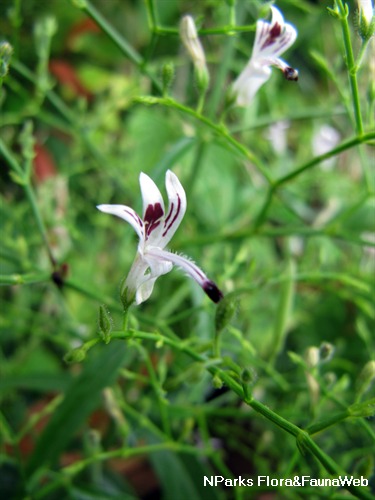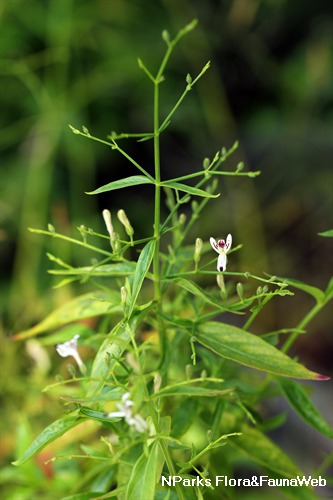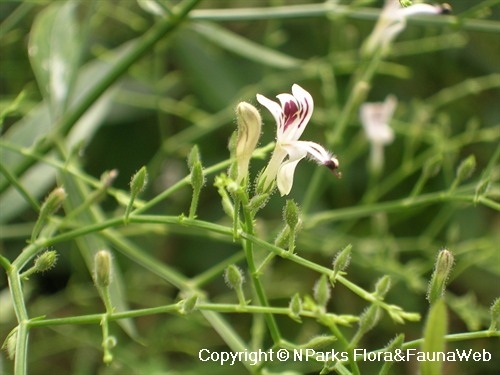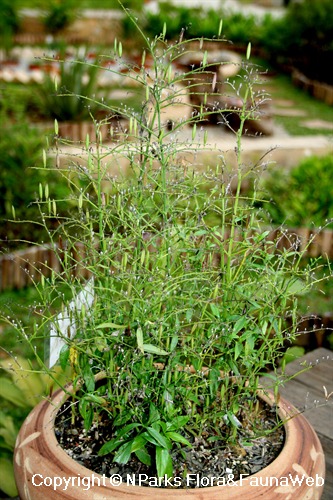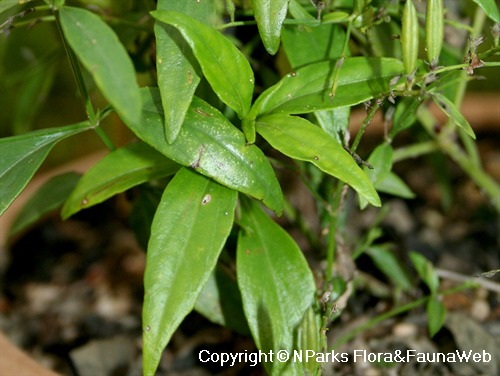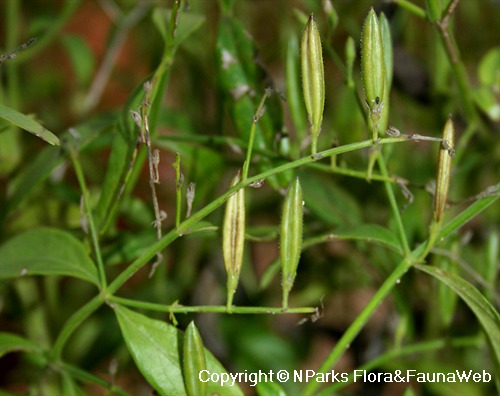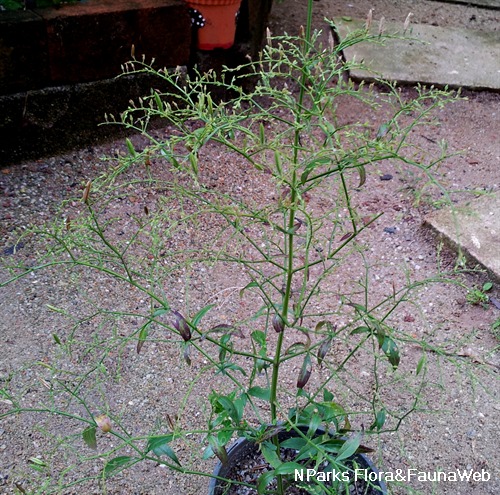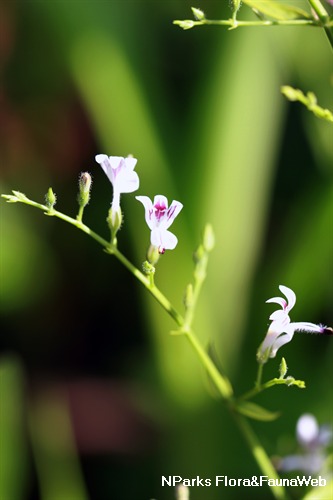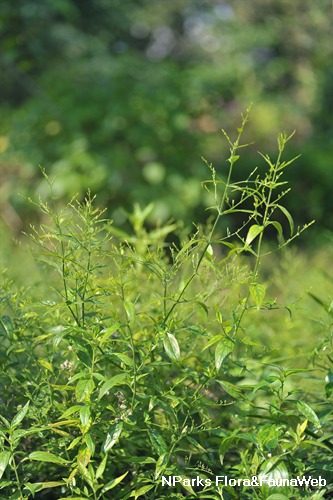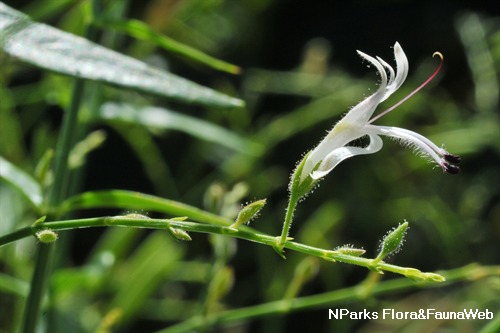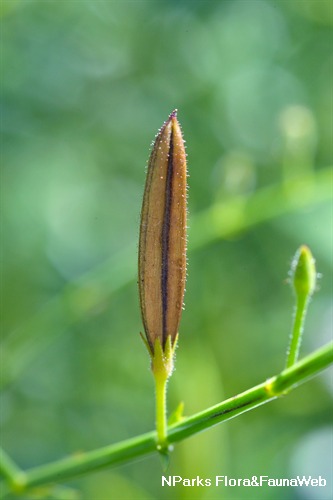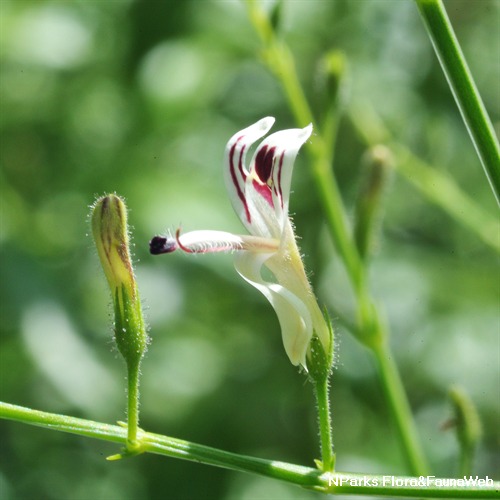
Back
Andrographis paniculata (Burm.f.) Wall. ex Nees
| Family Name: | Acanthaceae |
| Synonyms: | Justicia paniculata Burm.f. |
| Common Name: | Bitterweed, King of Bitters, Creat, Green Chireta, Indian Echinachea, 穿心莲, 四方蓮 |
Andrographis paniculata, commonly known as the King of Bitters, is named for its intensely bitter tasting leaves. In traditional Chinese and Indian medicine, it is used to reduce fever, inflammation, blood sugar and high blood pressure. This common weed in the tropics and subtropics grows well in most soil types in semi-shade. Its white flowers have purple streaks and can self-pollinate.
Name
Classifications and Characteristics
| Plant Division | Angiosperms (Flowering Seed Plants) (Dicotyledon) |
|---|---|
| Plant Growth Form | Herbaceous Plant |
| Lifespan (in Singapore) | Annual |
| Mode of Nutrition | Autotrophic |
| Maximum Height | 0.5 m |
Biogeography
| Native Distribution | India, Sri Lanka |
|---|---|
| Native Habitat | Terrestrial (Secondary Rainforest, Monsoon Forest, Coastal Forest, Disturbed Area / Open Ground) |
| Preferred Climate Zone | Tropical, Sub-Tropical / Monsoonal |
Description and Ethnobotany
| Growth Form | Annual herb with branched growth form up to 0.5 m tall. |
|---|---|
| Foliage | Leaves (1.5-7 cm long, 1-2.5 cm wide) are ovate-lanceolate (intermediate between egg-shaped and lance-shaped), lanceolate or narrowly elliptic (narrow oval). |
| Stems | Stems are hairless and 4-sided. |
| Flowers | Two-lipped, tubular flowers (0.9-1.5 cm long) are white with the lower lip having purple dots. The outer surface of the tube is covered in glandular hairs (hairs with glands at the tip). Flowers are arranged in a secund raceme (a spike-like inflorescence composed of stalked flowers that are all pointing in a single direction). The racemes are arranged in branched clusters near the stem tip known as terminal panicles. |
| Fruit | Dry, dehiscent fruit is known as a capsule (1.5-2 cm long, 0.3-0.4 cm wide). It has a flattened, oval shape. Each capsule contains about 12 wrinkled seeds (2 mm long, 1.5 mm wide). |
| Ethnobotanical Uses | Medicinal: Scientific Evidence of Medicinal Properties Pre-clinical and human clinical trials have shown that Bitterweed has anti-diabetic (Widjajakusuma et al., 2019), anti-inflammation (Burgos et al., 2009) and anti-microbial properties (Hu et al., 2017). Pre-clinical trials on animals indicate it has analgesic (Ilmi et al., 2021), anti-cancer (Yue et al., 2019), antioxidant (Dandu & Inamdar 2009), cholesterol-lowering (Verma et al., 2013) and anti-malarial properties (Dua et al., 2004). Traditional Medicinal Uses Research supports the traditional use of Bitterweed to treat diabetes and upper respiratory ailments, such as bronchitis. Other traditional uses include treating insect and snake bites and preventing cardiovascular disease such as hypertension. It is important to note that some therapeutic effects from traditional medicinal uses of plants are not currently supported or verified by scientific research. |
Landscaping Features
| Landscape Uses | General, Container Planting, Coastal |
|---|---|
| Thematic Landscaping | Economic Garden |
| Usage Hazard - Cons | Toxic Upon Ingestion |
| Usage Hazard - Cons Remarks | Plant has anti-fertility and abortive properties, may cause miscarriages if consumed in large quantities. |
Fauna, Pollination and Dispersal
| Seed or Spore Dispersal | Abiotic (Explosive Dehiscence) |
|---|
Plant Care and Propagation
| Light Preference | Full Sun |
|---|---|
| Water Preference | Moderate Water |
| Plant Growth Rate | Moderate |
| Rootzone Tolerance | Poor Infertile Soils, Well-Drained Soils, Fertile Loamy Soils, Saline Soils / Salt Spray, Easy to Grow |
| Propagation Method | Seed, Stem Cutting |
Foliar
| Foliage Retention | Evergreen |
|---|---|
| Mature Foliage Colour(s) | Green |
| Mature Foliage Texture(s) | Glossy / Shiny, Raised / Sunken Veins, Thin |
| Foliar Type | Simple / Unifoliate |
| Foliar Arrangement Along Stem | Opposite |
| Foliar Shape(s) | Non-Palm Foliage (Lanceolate) |
| Foliar Venation | Pinnate / Net |
| Foliar Margin | Entire |
| Foliar Apex - Tip | Acuminate |
| Foliar Base | Rounded / Obtuse |
| Typical Foliar Area | Microphyll ( 2.25cm2 - 20.25 cm2 ) |
| Leaf Area Index (LAI) for Green Plot Ratio | 4.5 (Shrub & Groundcover - Dicot) |
Non - Foliar and Storage
| Stem Type & Modification | Herbaceous |
|---|---|
| Root Type | Underground (Fibrous Root) |
Floral (Angiosperm)
| Flower & Plant Sexuality | Bisexual Flowers |
| Flower Colour(s) | Purple, White |
|---|---|
| Flower Size - Remarks | 1.2 cm |
| Inflorescence Type | Panicle |
| Flowering Habit | Polycarpic |
Fruit, Seed and Spore
| Mature Fruit Colour(s) | Brown |
|---|---|
| Fruit Classification | Simple Fruit |
| Fruit Type | Dehiscent Dry Fruit , Capsule |
| Mature Seed Texture(s) | Ridged / Corrugated, Wrinkled |
| Seed Quantity Per Fruit | Several (11-20) |
References
| References | <1> Burgos, R.A., Hancke, J.L., Bertoglio, J.C., Aguirre, V., Arriagada, S., Calvo, M. & Caceres, D.D. (2009). Efficacy of an Andrographis paniculata composition for the relief of rheumatoid arthritis symptoms: a prospective randomized placebo-controlled trial. Clinical Rheumatology 28(8): 931-946. <2> Dandu, A.M. & Inamdar, N.M. (2009). Evaluation of beneficial effects of antioxidant properties of aqueous leaf extract of Andrographis paniculata in STZ-induced diabetes. Pakistan Journal of Pharmaceutical Sciences 22: 49-52. <3> Dua, V.K., Ojha, V.P., Roy, R., Joshi, B.C., Valecha, N., Devi, C.U., Bhatnagar, M.C., Sharma, V.P. & Subbarao, S.K. (2004). Anti-malarial activity of some xanthones isolated from the roots of Andrographis paniculata. Journal of Ethnopharmacology 95(2-3): 247-251. <4> Hu, X.Y., Wu, R.H., Logue, M., Blondel, C., Lai, L.Y.W., Stuart, B., Flower, A., Fei, Y.T., Moore, M., Shepherd, J., Liu, J.P. & Lewith, G. (2017). Andrographis paniculata (Chuan Xin Lian) for symptomatic relief of acute respiratory tract infections in adults and children: A systematic review and meta-analysis. PLoS ONE 12(8): e0181780. <5> Ilmi, H., Pamungkas I.R., Tumewu, L., Hafid, A.F. & Widyawaruyanti, A. (2021). Analgesic and antipyretic activities of ethyl acetate fraction tablet of Andrographis paniculata in animal models. Evidence-Based Complementary and Alternative Medicine Article ID 8848797. <6> Okhuarobo, A., Falodun, J.E., Erharuyi, O., Imieje, V., Falodun, A. & Langer, P. (2014). Harnessing the medicinal properties of Andrographis paniculata for diseases and beyond: a review of its phytochemistry and pharmacology. Asian Pacific Journal of Tropical Disease 4(3): 213-222. <7> Verma, V.K., Sarwa, K.K. & Zaman, M.K. (2013). Antihyperglycemic activity of Swertia chirayita and Andrographis paniculata plant extracts in streptozotocin-induced diabetic rats. International Journal of Pharmacy and Pharmaceutical Sciences 5(3): 305-311. <8> Widjajakusuma, E.C., Jonosewojo, A., Hendriata, L., Wijaya, S., Ferawati, Surjadhana, A., Sastrowardoyo, W., Monita, N., Muna, N.M., Fajarwati, R.P., Ervina, M., Esar, S.Y., Soegianto, L., Lang, T. & Heriyanti, C. (2019). Phytochemical screening and preliminary clinical trials of the aqueous extract mixture of Andrographis paniculata (Burm.f.) Wall. ex Nees and Syzygium polyanthum (Wight.) Walp leaves in metformin treated patients with type 2 diabetes. Phytomedicine 55: 137-147. <9> Yue, G.G.L., Li, L., Lee, J.K.M., Kwok, H.F., Wong, E.C.W., Li, M., Fung, K.P., Yu, J., Chan, A.W.H., Chiu, P.W.Y. & Lau, C.B.S. (2019). Multiple modulatory activities of Andrographis paniculata on immune responses and xenograft growth in esophageal cancer preclinical models. Phytomedicine 60: Article 152886. |
|---|
Image Repository
Others
| Master ID | 369 |
|---|---|
| Species ID | 1665 |
| Flora Disclaimer | The information in this website has been compiled from reliable sources, such as reference works on medicinal plants. It is not a substitute for medical advice or treatment and NParks does not purport to provide any medical advice. Readers should always consult his/her physician before using or consuming a plant for medicinal purposes. |

